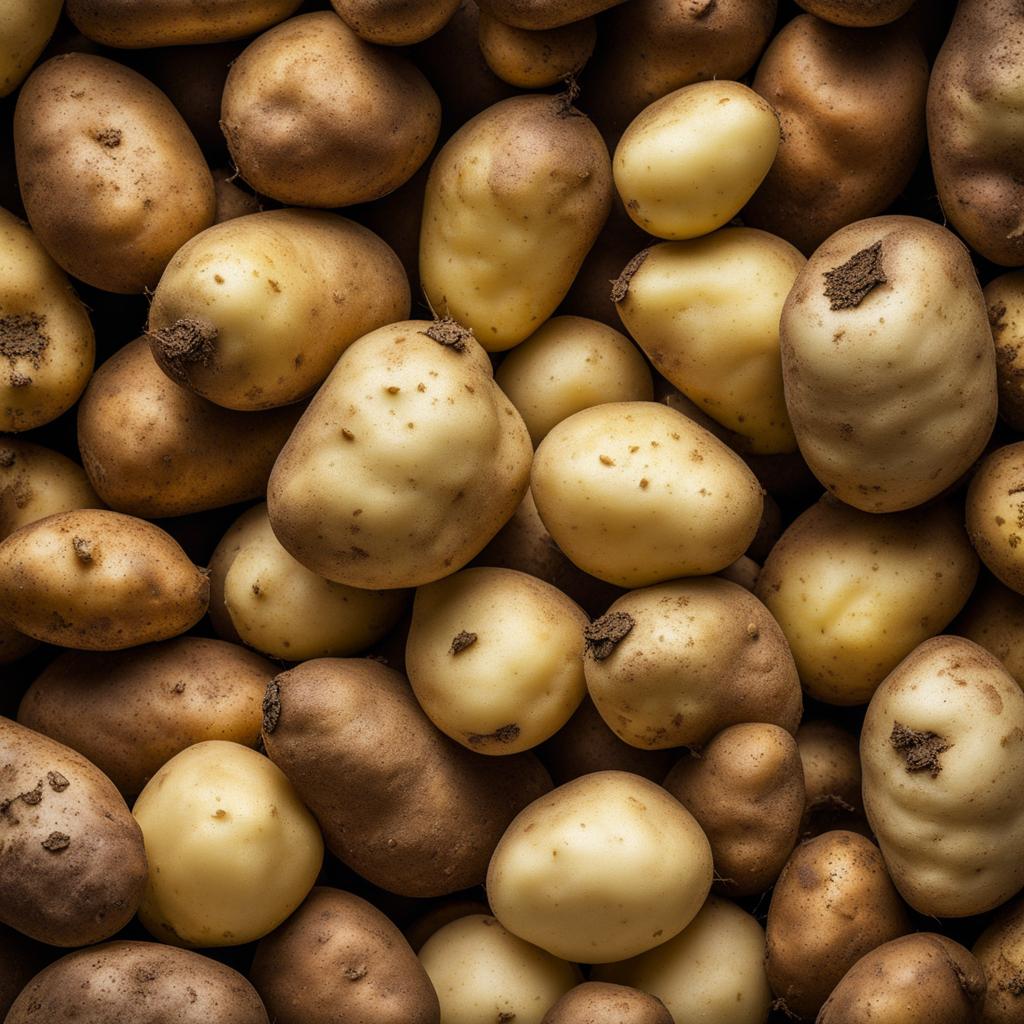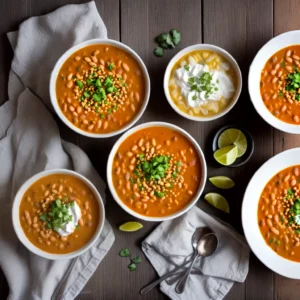Potatoes are a versatile and beloved ingredient in the culinary world. To ensure their freshness and avoid wastage, it’s important to store them properly. In this guide, I will provide you with expert tips on how to store potatoes and keep them fresh in your kitchen. These storage techniques will help prolong the shelf life of your potatoes and maintain their flavor and texture for all your cooking needs.
Key Takeaways:
- Proper storage techniques help maintain the freshness and flavor of potatoes.
- Do not store potatoes in the refrigerator or expose them to direct sunlight.
- Choose a cool and dark location, like a pantry or basement, for storing potatoes.
- Use well-ventilated containers to prevent moisture buildup.
- Avoid storing potatoes with fruits like apples or onions, as they can lead to spoilage.
The Importance of Proper Storage for Potatoes
Potatoes are a staple ingredient in many kitchens, offering versatility and deliciousness in a variety of dishes. To fully enjoy their flavor and extend their shelf life, it is essential to store potatoes correctly. Improper storage can lead to spoilage, sprouting, and a loss of taste and texture.
Proper potato storage is important for several reasons. Firstly, it helps to maintain the freshness and quality of the potatoes, ensuring that they remain flavorful and nutritious. Secondly, it prevents the growth of harmful bacteria and reduces the risk of foodborne illnesses. Lastly, proper storage techniques allow you to maximize the usability of potatoes, using them in a wide range of recipes.
When stored correctly, potatoes can last for several weeks or even months. The key is to provide them with the right conditions. Potatoes should be stored in a cool, dark, and well-ventilated place, such as a pantry or cellar. Avoid storing them in the refrigerator, as the cold temperature can convert the starch in potatoes to sugar, resulting in a loss of taste and texture. Additionally, keep potatoes away from direct sunlight to prevent them from turning green and producing solanine, which is toxic in high amounts.
By understanding the importance of proper potato storage, you can ensure that your favorite tubers stay fresh and delicious for longer, reducing waste and maximizing their culinary potential.
Avoiding Common Storage Mistakes
Proper storage is key when it comes to keeping your potatoes fresh and delicious. To ensure their longevity, it’s important to avoid some common storage mistakes that can lead to sprouting, loss of flavor, and texture.
Storing Potatoes in the Refrigerator
One common mistake is storing potatoes in the refrigerator. The cold temperature of the fridge can cause the starch in the potatoes to turn into sugar, leading to an unpleasant taste and texture. Instead, store your potatoes in a cool, dark place like a pantry or cellar.
Avoiding Exposure to Light
Another mistake to avoid is exposing your potatoes to direct light. Light exposure causes potatoes to turn green and produce a compound called solanine, which can be toxic if consumed in large amounts. To prevent this, store your potatoes in a well-ventilated container or a paper bag to protect them from light.
Proper Moisture Control
Moisture control is also important to avoid common storage mistakes. Potatoes should be stored in a dry environment to prevent them from becoming damp and promoting bacterial growth. Avoid using airtight containers or sealed plastic bags, as they can trap moisture. Instead, opt for well-ventilated containers such as cardboard boxes, mesh bags, or baskets.
By avoiding these common storage mistakes, you can ensure that your potatoes stay fresh and delicious for longer, maintaining their flavor, texture, and nutritional value. Remember to store them in a cool, dark place, protect them from light, and maintain proper moisture control. With these storage techniques, you can enjoy the full potential of your potatoes in your culinary adventures.
The Importance of Choosing the Right Storage Location for Potatoes
When it comes to storing potatoes, choosing the right location is crucial in maintaining their freshness and quality. The ideal storage temperature for potatoes is between 45 to 50 degrees Fahrenheit (7 to 10 degrees Celsius). A cool and dark place, such as a pantry or an unheated basement, is the perfect spot for storing potatoes.
Storing potatoes in the pantry or basement helps to maintain a consistent temperature, preventing them from sprouting or spoiling prematurely. Avoid placing them on top of the refrigerator or next to the stove, as these areas tend to be warmer and can accelerate sprouting and spoilage.
By storing potatoes in the right location, you can ensure that they stay fresh and flavorful for a longer period of time. This will not only help reduce food waste but also allow you to enjoy the nutritional benefits and culinary versatility of potatoes in your meals.
Table: Ideal Storage Locations for Potatoes
| Storage Location | Ideal Temperature |
|---|---|
| Pantry | 45-50°F (7-10°C) |
| Unheated Basement | 45-50°F (7-10°C) |
| Refrigerator | Not recommended |
| Above Refrigerator | Not recommended |
| Next to Stove | Not recommended |
In summary, choosing the right storage location is crucial for maintaining the freshness and quality of potatoes. A cool and dark place, such as a pantry or an unheated basement, is the ideal spot. Avoid storing them in the refrigerator, above the refrigerator, or next to the stove. By following these guidelines, you can extend the shelf life of your potatoes and enjoy their deliciousness in various culinary creations.
Proper Packaging and Ventilation
When it comes to storing potatoes, proper packaging and ventilation are key factors in maintaining their freshness and quality. Using the right containers and ensuring adequate airflow can help prevent spoilage and preserve the flavor and texture of your potatoes.
Airtight Containers: While airtight containers are commonly used for storing food, they are not suitable for potatoes. Potatoes need some level of ventilation to prevent the build-up of moisture, which can lead to rotting. Instead, opt for well-ventilated containers such as cardboard boxes, mesh bags, or baskets. These containers allow for air circulation, preventing excess moisture from accumulating and prolonging the shelf life of your potatoes.
Moisture Control: Moisture is one of the main culprits behind potato spoilage. It’s crucial to keep your potatoes dry during storage to prevent the growth of bacteria and mold. Before placing potatoes in their storage container, make sure they are fully dry. Additionally, avoid washing potatoes before storage, as moisture can seep into the potato and contribute to spoilage. If you notice any moisture within the storage container, remove the potatoes, dry the container thoroughly, and return the potatoes once the container is completely dry.
Ventilation: Good ventilation is crucial for maintaining the freshness of potatoes. It helps to circulate air and prevent the accumulation of moisture. When storing potatoes, ensure that there is some airflow around them. You can achieve this by leaving gaps between the potatoes in the storage container or using containers with mesh sides. Avoid crowding the potatoes too tightly, as it can restrict airflow and increase the chances of spoilage.
🧐 Tip: Remember to regularly check your stored potatoes for any signs of spoilage or rot. Remove any potatoes that have started to decay to prevent the spread of bacteria to other potatoes.
| Containers | Pros | Cons |
|---|---|---|
| Cardboard boxes | Allow for good ventilation, easy to stack and store | May not provide as much protection from light exposure |
| Mesh bags | Excellent ventilation, lightweight and portable | Less protection from bruising or physical damage |
| Baskets | Natural ventilation, aesthetically pleasing | May take up more space and can be prone to pests |
Tips for Storing Potatoes with Other Produce
When it comes to storing potatoes with other produce in your kitchen, it’s important to consider their compatibility to ensure optimal freshness. Some fruits, such as apples, produce a gas called ethylene, which can accelerate the ripening process of potatoes.
Storing potatoes with apples can lead to potatoes sprouting faster and potentially spoiling sooner. To prevent this, it’s best to store potatoes and apples separately.
Additionally, storing potatoes with onions is not recommended. Onions have a high moisture content, which can cause potatoes to spoil faster. It’s best to keep onions and potatoes in different storage areas to help extend their shelf life.
Signs of Spoilage
When it comes to storing potatoes, it’s important to know the signs of spoilage. By being able to identify these signs, you can ensure that you’re using fresh and safe potatoes in your culinary creations. Here are some common indicators of spoilage to be aware of:
- Mold: If you notice any fuzzy spots or patches of mold on your potatoes, it’s best to discard them. Mold can spread quickly and can be harmful if consumed.
- Soft Spots: Potatoes should be firm to the touch. If you find any soft, mushy areas on your potatoes, it’s a sign that they may have started to rot.
- Musty Smell: A strong, unpleasant odor coming from your potatoes is a clear sign of spoilage. If they emit a musty or rotten smell, it’s best to throw them away.
- Green Areas: Green spots or patches on potatoes indicate exposure to light. These areas contain solanine, a toxic compound that can cause a bitter taste and should be removed before consumption.
By inspecting your potatoes for these signs of spoilage, you can ensure that you’re using fresh and safe ingredients in your cooking. Remember to always discard any potatoes that show these signs to prevent any potential health risks.
Table: Signs of Potato Spoilage
| Sign of Spoilage | Description |
|---|---|
| Mold | Fuzzy spots or patches of mold on the potatoes |
| Soft Spots | Areas of the potato that are mushy or soft to the touch |
| Musty Smell | A strong, unpleasant odor emanating from the potatoes |
| Green Areas | Green spots or patches on the potatoes |
By familiarizing yourself with these signs of spoilage, you can ensure that the potatoes you use in your kitchen are fresh, flavorful, and safe to eat.
The Versatility of Potatoes in Cooking
Potatoes are incredibly versatile in the kitchen and can be used in a wide range of delicious recipes. Whether you prefer them mashed, roasted, fried, or baked, potatoes add a hearty and satisfying element to any dish. Their mild flavor and diverse texture make them suitable for a multitude of culinary creations.
One popular way to enjoy potatoes is by making classic mashed potatoes. Creamy and smooth, mashed potatoes are a staple side dish that pairs well with roasted meats, grilled vegetables, or as a base for savory gravy. With some butter, milk, and seasoning, you can transform boiled potatoes into a comforting and mouthwatering dish.
If you prefer a crispy and crunchy texture, you can try making homemade potato chips. Thinly sliced and fried until golden brown, potato chips are a favorite snack for many. You can customize the seasoning to your taste, whether you prefer a classic salt and vinegar flavor or something more adventurous like barbecue or sour cream and onion.
Baked potatoes are another versatile option that can be enjoyed as a main course or a side dish. Simply bake a potato until the skin is crispy and the inside is fluffy, then add your favorite toppings such as sour cream, chives, cheese, or bacon. The possibilities are endless, and you can get creative with different combinations to suit your preferences.
Table: Different Potato Varieties and Their Uses
| Potato Variety | Texture | Best Uses |
|---|---|---|
| Russet Potatoes | Fluffy and dry | Baking, mashing |
| Yukon Gold Potatoes | Buttery and creamy | Roasting, boiling, mashing |
| Red Potatoes | Firm and waxy | Roasting, boiling, salads |
| Sweet Potatoes | Moist and tender | Baking, roasting, fries |
Different potato varieties offer unique flavors and textures, allowing you to experiment with various cooking methods and recipes. Russet potatoes, with their fluffy texture, are best suited for baking and mashing. Yukon Gold potatoes have a buttery and creamy texture, making them perfect for roasting, boiling, or mashing. Red potatoes are firm and waxy, making them ideal for roasting, boiling, or using in salads. Sweet potatoes have a moist and tender texture and are great for baking, roasting, or making fries.
Don’t limit yourself to just one way of using stored potatoes. Get creative in the kitchen and explore the versatility of this humble vegetable. Whether you’re cooking for yourself or hosting a dinner party, potatoes are sure to please everyone’s taste buds.
Importance of Food Safety in Potato Storage
When it comes to storing potatoes, ensuring food safety is of utmost importance. Proper storage techniques not only help maintain the freshness and quality of potatoes but also prevent the growth of harmful bacteria.
One key aspect of food safety in potato storage is handling and storing the potatoes in a clean and hygienic manner. Before storing, it is essential to inspect the potatoes for any signs of spoilage or mold. Any potatoes that are soft, shriveled, or have an off-smell should be discarded to avoid contamination.
In addition to proper handling, regularly checking the storage environment is crucial. Keep an eye out for any signs of excess moisture or pests, as these can lead to bacterial growth or infestation. Taking appropriate measures to control moisture and pests will contribute to maintaining the safety and quality of your stored potatoes.
By prioritizing food safety in potato storage, you can enjoy the nutritional benefits of potatoes without any health risks. Remember to follow proper storage techniques, handle potatoes with care, and regularly inspect the storage environment to ensure safe and healthy consumption.
| Food Safety Guidelines for Potato Storage | Importance |
|---|---|
| Handle and store potatoes in a clean and hygienic manner. | Prevents contamination and the growth of harmful bacteria. |
| Regularly inspect potatoes for signs of spoilage or mold. | Avoids consumption of spoiled or contaminated potatoes. |
| Check the storage environment for excess moisture or pests. | Prevents bacterial growth and infestation. |
Tips for Quick Access and Convenience
When it comes to storing potatoes in your kitchen, convenience is key. Here are some helpful tips to ensure quick access and easy storage of your potatoes:
- Choose an easily accessible location: Keep your stored potatoes in a convenient spot in your kitchen, such as a drawer or a basket on the countertop. This way, you can easily reach for a potato whenever you need one for cooking or meal preparation.
- Label your storage containers: To save time and effort, label your storage containers with the type of potatoes they contain. This will help you quickly identify the variety you need without having to open multiple containers.
- Organize by freshness: Arrange your stored potatoes in order of freshness, placing the oldest ones towards the front. This way, you can prioritize using the older potatoes first and ensure that none go to waste.

By following these simple tips, you can make storing and using potatoes in your kitchen more convenient than ever. Whether you’re whipping up a batch of creamy mashed potatoes or adding some roasted potatoes to your favorite dish, quick access to fresh potatoes will make your culinary endeavors a breeze.
Maximizing the Shelf Life of Potatoes
When it comes to storing potatoes, maximizing their shelf life is essential to avoid wastage. By following a few freshness hacks, you can ensure that your potatoes stay fresh and usable for a longer period of time. Here are some tips to help you extend the shelf life of your stored potatoes:
- Avoid washing the potatoes before storage. Moisture can increase the risk of bacterial or fungal growth. Instead, gently brush off any dirt or debris from the potatoes before storing them.
- Regularly check the storage environment for signs of excess moisture or pests. Potatoes should be stored in a cool and dark place, but make sure the area is not too humid or prone to insect infestations.
- Remove any damaged or spoiled potatoes from the storage container. A single rotten potato can quickly spread rot to the rest of the batch, so it’s important to identify and discard any potatoes that show signs of spoilage.
- Consider using breathable storage containers such as cardboard boxes or mesh bags. These containers allow for proper airflow, preventing the buildup of moisture and reducing the risk of spoilage.
By implementing these freshness hacks, you can maximize the shelf life of your stored potatoes and minimize food waste in your kitchen.
Remember: proper storage techniques are key to maintaining the flavor, texture, and nutritional value of your potatoes. By taking the necessary precautions, you can enjoy fresh and delicious potatoes for longer periods of time.
Now that you have learned how to store potatoes and keep them fresh, it’s time to put this knowledge into practice. Use these freshness hacks to make the most out of your potato storage and enjoy the versatility of this culinary staple in your favorite recipes.
| Storage Hack | Benefits |
|---|---|
| Avoid washing potatoes before storage | Prevents excess moisture and bacterial/fungal growth |
| Regularly check for excess moisture or pests | Maintains a suitable storage environment and prevents spoilage |
| Remove damaged or spoiled potatoes | Prevents the spread of rot to other potatoes |
| Use breathable storage containers | Allows proper airflow and reduces the risk of spoilage |
The Versatility of Potatoes in Cooking
Potatoes are incredibly versatile when it comes to cooking, making them a staple ingredient in the culinary world. Whether you’re baking, frying, roasting, or boiling, potatoes can be used in a wide range of recipes to create delicious and satisfying dishes. Their mild flavor and diverse texture make them suitable for various culinary applications, allowing you to get creative in the kitchen.
One of the most popular ways to cook potatoes is by mashing them. Creamy and smooth, mashed potatoes are a classic side dish that pairs well with many main courses. You can customize your mashed potatoes by adding ingredients like garlic, herbs, cheese, or sour cream to enhance the flavor.
Another favorite potato dish is crispy homemade french fries. Cut the potatoes into thin strips, toss them in oil and seasoning, and bake or fry them until golden and crunchy. French fries make a delicious snack or accompaniment to burgers, sandwiches, or grilled meats.
Potatoes can also be transformed into comforting potato soups, hearty potato gratins, or even savory potato pancakes. Their versatility allows you to experiment with different flavors and techniques in your cooking.
When it comes to baking, potatoes can be used to create a variety of dishes. From fluffy potato rolls to crispy potato skins, the options are endless. You can also stuff potatoes with a variety of fillings such as cheese, bacon, or vegetables for a hearty and satisfying meal.
Potato Recipe Ideas:
- Potato Salad: A classic side dish perfect for picnics, barbecues, and potlucks.
- Scalloped Potatoes: Thinly sliced potatoes layered with cheese and cream, baked to perfection.
- Potato Pancakes: Shredded potatoes mixed with eggs and flour, then fried until golden brown.
- Roasted Potatoes: Tossed in olive oil and seasoned with herbs, roasted until crispy on the outside and tender on the inside.
- Potato Soup: A comforting and creamy soup made with potatoes, broth, and seasonings.
As you can see, potatoes are truly versatile in the kitchen, offering endless possibilities for delicious meals. Whether you’re cooking for a crowd or just for yourself, potatoes are a reliable and versatile ingredient that can elevate any dish. So go ahead, get creative, and discover the many ways you can enjoy the versatility of potatoes in your cooking!

The Nutritional Value of Potatoes
Potatoes are a staple in many culinary traditions and kitchens around the world. They not only provide versatility in cooking but also offer significant nutritional value. Potatoes are a good source of essential vitamins, minerals, and dietary fiber, making them a valuable addition to a well-balanced diet.
One of the key nutrients found in potatoes is vitamin C. Vitamin C is an antioxidant that supports immune function, helps with collagen synthesis, and aids in iron absorption. A medium-sized potato can provide about 45% of the recommended daily intake of vitamin C.
Potatoes are also rich in potassium, with a medium-sized potato containing more potassium than a banana. Potassium is essential for maintaining proper heart and muscle function, regulating blood pressure, and balancing fluid levels in the body.
In addition to vitamin C and potassium, potatoes contain various B vitamins, including vitamin B6. Vitamin B6 plays a crucial role in brain development and function, helps produce neurotransmitters, and supports the formation of red blood cells.
“Potatoes are a nutrient-dense food that can be included in a balanced diet. They provide essential vitamins, minerals, and dietary fiber, which are important for overall health and well-being.”
Potatoes also offer dietary fiber, which aids in digestion and helps maintain a healthy digestive system. The fiber content in potatoes can contribute to feelings of fullness, aiding in weight management and promoting a healthy gut.
When incorporating potatoes into your meals, it’s essential to consider different cooking methods that preserve their nutritional value. Baking or steaming potatoes with the skin intact can help retain the maximum amount of nutrients. Avoid deep-frying or excessively adding fats and oils, as this can increase the calorie content and negate some of the health benefits of potatoes.
With their nutritional value and culinary versatility, potatoes are a valuable ingredient that can be enjoyed in a variety of dishes. By understanding their nutritional benefits and incorporating them into a balanced diet, you can make the most of this humble vegetable in your kitchen.
Considerations for Different Potato Varieties
When it comes to storing different potato varieties, it’s important to take into account their unique characteristics. Two popular potato varieties that require special considerations are russet potatoes and sweet potatoes. Understanding these considerations will help you store and utilize them effectively in your kitchen.
Russet Potatoes
Russet potatoes are known for their fluffy texture, making them ideal for baking and mashing. When storing russet potatoes, you can follow general storage guidelines. Store them in a cool, dark place with proper ventilation, such as a pantry or unheated basement, at a temperature between 45 to 50 degrees Fahrenheit (7 to 10 degrees Celsius). Remember to keep them away from direct sunlight and sources of heat to prevent sprouting and spoilage.
Sweet Potatoes
Sweet potatoes have a higher sugar content compared to other potato varieties and should be stored slightly differently. Keep sweet potatoes in a location that is slightly warmer, around 55 degrees Fahrenheit (13 degrees Celsius). Similar to russet potatoes, store them in a cool and dark place with good ventilation. Ensure they are not exposed to light, as this can cause them to turn green and produce solanine. By providing the right storage conditions, you can preserve the flavor and texture of sweet potatoes.
Overall, considering the specific needs of different potato varieties will help maintain their freshness and quality for longer periods. By storing russet potatoes and sweet potatoes correctly, you can enjoy their versatility and unique flavors in your culinary creations.
Conclusion
So there you have it – my top tips and tricks for storing potatoes and keeping them fresh in your kitchen. By following these guidelines, you can ensure that your potatoes stay in the best possible condition, ready to be used in your favorite culinary creations.
Remember to store your potatoes in a cool, dark place with good ventilation. Avoid exposing them to light, as this can cause them to turn green and produce harmful compounds. Additionally, take the time to regularly inspect your stored potatoes for any signs of spoilage, such as mold or soft spots.
With these freshness hacks and storage techniques, you can extend the shelf life of your potatoes and maximize their usability. Whether you’re roasting them to perfection, mashing them into creamy goodness, or frying them for a crispy treat, your stored potatoes will always be at their best.
So go ahead, stock up on potatoes and enjoy the convenience and versatility they bring to your kitchen. With these tips and tricks, you’ll never have to worry about your potatoes going to waste again!
FAQ
How should I store potatoes to keep them fresh?
Potatoes should be stored in a cool and dark place, such as a pantry or unheated basement, at a temperature between 45 to 50 degrees Fahrenheit (7 to 10 degrees Celsius). Avoid storing them in the refrigerator, as it can result in unpleasant taste and texture.
Can I store potatoes in airtight containers?
No, potatoes should be stored in well-ventilated containers such as cardboard boxes, mesh bags, or baskets. Airtight containers or sealed plastic bags can trap moisture and promote bacterial growth.
Should I store potatoes with other produce?
It is best to keep potatoes separate from fruits such as apples, which produce ethylene gas that can accelerate the ripening process of potatoes. Storing potatoes with onions can lead to faster spoilage due to their high moisture content.
How can I tell if potatoes have gone bad?
Mold, soft spots, and a musty smell are signs of spoilage. Green areas on the potatoes indicate exposure to light and the presence of solanine, a compound that can be harmful if consumed in large amounts.
What are some cooking ideas for stored potatoes?
Stored potatoes can be used in a variety of recipes, such as mashed, roasted, fried, or baked dishes. Explore the versatility of potatoes and get creative in the kitchen.
How can I ensure food safety when storing potatoes?
Handle and store potatoes in a clean and hygienic manner. Regularly inspect stored potatoes for signs of spoilage or mold, and discard any that are soft, shriveled, or have an off-smell.
How can I maximize the shelf life of stored potatoes?
Avoid washing potatoes before storage, remove any damaged or spoiled potatoes from the storage container, regularly check for excess moisture or pests, and take appropriate measures to control them.
What are the nutritional benefits of potatoes?
Potatoes are a good source of vitamins, minerals, and dietary fiber. They contain essential nutrients such as vitamin C, potassium, and B vitamins.
Are there different storage considerations for different potato varieties?
Yes, different potato varieties have unique characteristics. Russet potatoes are best for baking and mashing and can be stored similarly to other varieties. Sweet potatoes, with a higher sugar content, should be stored in a slightly warmer location.
Source Links
- https://www.marthastewart.com/8344215/how-to-store-potatoes-avoid-sprouting
- https://www.southernliving.com/food/veggies/potatoes/how-to-store-potatoes
- https://food52.com/blog/14613-the-best-way-to-store-potatoes
Related Recipes:
 How to Store Limes to Preserve Their Freshness
How to Store Limes to Preserve Their Freshness
 How to Store Fish to Ensure Freshness
How to Store Fish to Ensure Freshness
 Mashed Potatoes: How Long Do They Last?
Mashed Potatoes: How Long Do They Last?
 How to Cook Air Fryer Potatoes? (Perfect Step-By-Step Guide)
How to Cook Air Fryer Potatoes? (Perfect Step-By-Step Guide)
 How to Freeze Sweet Potatoes: A Guide
How to Freeze Sweet Potatoes: A Guide
 How to Store Dry Pasta for Long-term Use
How to Store Dry Pasta for Long-term Use
 How to Store Carrots? (Perfect Every Time!)
How to Store Carrots? (Perfect Every Time!)
 Pineapple Storage: Tips for Longevity
Pineapple Storage: Tips for Longevity








